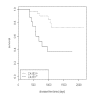CA 15-3 is predictive of response and disease recurrence following treatment in locally advanced breast cancer
- PMID: 16953875
- PMCID: PMC1590047
- DOI: 10.1186/1471-2407-6-220
CA 15-3 is predictive of response and disease recurrence following treatment in locally advanced breast cancer
Abstract
Background: Primary chemotherapy (PC) is used for down-staging locally advanced breast cancer (LABC). CA 15-3 measures the protein product of the MUC1 gene and is the most widely used serum marker in breast cancer.
Methods: We retrospectively investigated the role of CA 15-3 in conjunction with other clinico-pathological variables as a predictor of response and time to disease recurrence following treatment in LABC. Pre and post primary chemotherapy serum concentrations of CA 15-3 together with other variables were reviewed and related to four outcomes following primary chemotherapy (clinical response, pathological response, time to recurrence and time to progression). Persistently elevated CA 15-3 after PC was considered as consecutively high levels above the cut off point during and after PC.
Results: 73 patients were included in this study. Patients received PC (AC or AC-T regimen) for locally advanced breast cancer. 54 patients underwent surgery. The median follow up was 790 days. Patients with high concentrations of CA 15-3 before PC treatment had a poor clinical (p = 0.013) and pathological (p = 0.044) response. Together with Her-2/neu expression (p = 0.009) and tumour lympho-vascular space invasion (LVI) (p = 0.001), a persistently elevated CA 15-3 post PC (p = 0.007) was an independent predictive factor of recurrence following treatment in LABC.
Conclusion: Elevated CA 15-3 level is predictive of a poor response to chemotherapy. In addition, persistently elevated CA 15-3 levels post chemotherapy in conjunction with lympho-vascular invasion and HER2 status predict a reduced disease free survival following treatment in locally advanced breast cancer.
Figures



Similar articles
-
Serum Tumor Marker Levels might have Little Significance in Evaluating Neoadjuvant Treatment Response in Locally Advanced Breast Cancer.Asian Pac J Cancer Prev. 2015;16(11):4603-8. doi: 10.7314/apjcp.2015.16.11.4603. Asian Pac J Cancer Prev. 2015. PMID: 26107211
-
Elevated chemokine receptor CXCR4 expression in primary tumors following neoadjuvant chemotherapy predicts poor outcomes for patients with locally advanced breast cancer (LABC).Breast Cancer Res Treat. 2009 Jan;113(2):293-9. doi: 10.1007/s10549-008-9921-8. Epub 2008 Feb 13. Breast Cancer Res Treat. 2009. PMID: 18270814 Clinical Trial.
-
A Multicenter Study of the Impact of Body Mass Index (BMI) on the incidence of Pathologic Complete Response (pCR) Among Saudi Patients with locally advanced Breast cancer (LABC) post Neoadjuvant Chemotherapy (NAC).Gulf J Oncolog. 2019 May;1(30):33-42. Gulf J Oncolog. 2019. PMID: 31242980
-
Detection of disseminated tumor cells in locally advanced breast cancer patients before primary systemic therapy.Breast. 2013 Oct;22(5):908-13. doi: 10.1016/j.breast.2013.04.014. Epub 2013 May 15. Breast. 2013. PMID: 23683695
-
Overview of resistance to systemic therapy in patients with breast cancer.Adv Exp Med Biol. 2007;608:1-22. doi: 10.1007/978-0-387-74039-3_1. Adv Exp Med Biol. 2007. PMID: 17993229 Review.
Cited by
-
Significantly higher serum tumor marker levels in patients with oral submucous fibrosis.J Dent Sci. 2021 Jul;16(3):846-853. doi: 10.1016/j.jds.2021.02.009. Epub 2021 Mar 11. J Dent Sci. 2021. PMID: 34141098 Free PMC article.
-
Soluble MUC1 and serum MUC1-specific antibodies are potential prognostic biomarkers for platinum-resistant ovarian cancer.Cancer Immunol Immunother. 2011 Jul;60(7):975-84. doi: 10.1007/s00262-011-1010-x. Epub 2011 Apr 2. Cancer Immunol Immunother. 2011. PMID: 21461842 Free PMC article.
-
Study of Glutathione S-Transferase, Its Isoenzyme (Pi), and Tumor Markers (CA15-3, HE4) in Breast Carcinoma Patients (Before and After Treatment).J Pharm Bioallied Sci. 2025 May;17(Suppl 1):S113-S116. doi: 10.4103/jpbs.jpbs_1790_24. Epub 2025 Apr 25. J Pharm Bioallied Sci. 2025. PMID: 40511194 Free PMC article. Review.
-
Diagnostic Accuracy of Cancer Antigen 15-3 as a Seromarker Among Recurrent Breast Carcinoma in Bangladesh.Cureus. 2024 Sep 2;16(9):e68448. doi: 10.7759/cureus.68448. eCollection 2024 Sep. Cureus. 2024. PMID: 39360039 Free PMC article.
-
Factors predicting survival in patients with locally advanced pancreatic cancer undergoing pancreatectomy with arterial resection.Updates Surg. 2021 Feb;73(1):233-249. doi: 10.1007/s13304-020-00883-7. Epub 2020 Sep 25. Updates Surg. 2021. PMID: 32978753 Free PMC article.
References
-
- De Lena M, Zucali R, Viganotti G, Valagussa P, Bonadonna G. Combined chemotherapy-radiotherapy approach in locally advanced (T3b-T4) breast cancer. Cancer Chemother Pharmacol. 1978;1:53–9. - PubMed
-
- Schwartz G. Neoadjuvant induction chemotherapy. Minerva Ginecol. 2005;57:327–48. - PubMed
-
- Kandioler-Eckersberger D, Ludwig C, Rudas M, Kappel S, Janschek E, Wenzel C, Schlagbauer-Wadl H, Mittlbock M, Gnant M, Steger G, Jakesz R. TP53 mutation and p53 over expression for prediction of response to neoadjuvant treatment in breast cancer patients. Clin Cancer Res. 2000;6:50–6. - PubMed
-
- Ogston KN, Miller ID, Schofield AC, Spyrantis A, Pavlidou E, Sarkar TK, Hutcheon AW, Payne S, Heys SD. Can patients' likelihood of benefiting from primary chemotherapy for breast cancer be predicted before commencement of treatment? Breast Cancer Res Treat. 2004;86:181–189. doi: 10.1023/B:BREA.0000032986.00879.d7. - DOI - PubMed
Publication types
MeSH terms
Substances
LinkOut - more resources
Full Text Sources
Medical
Research Materials
Miscellaneous

